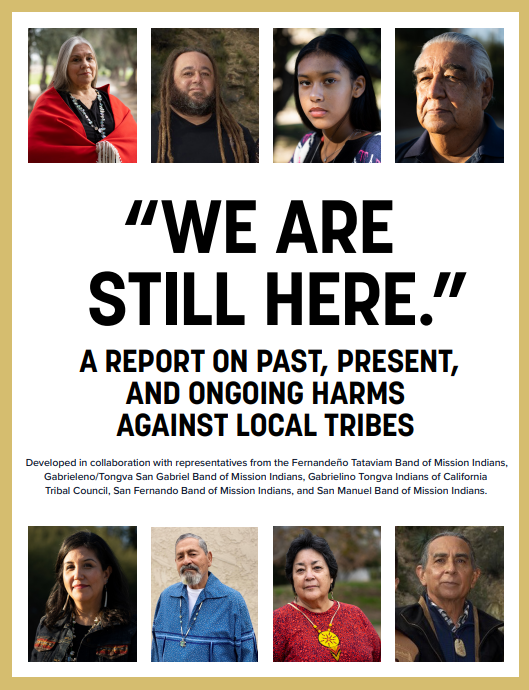
Land Acknowledgment
Developed over many months of collaboration with leaders from local Tribes, on November 1, 2022, the Board of Supervisors unanimously voted to adopt a Land Acknowledgment for the County of Los Angeles. Please see below for a toolkit and other resources.
The County of Los Angeles recognizes that we occupy land originally and still inhabited and cared for by the Tongva, Tataviam, Serrano, Kizh, and Chumash Peoples. We honor and pay respect to their elders and descendants — past, present, and emerging — as they continue their stewardship of these lands and waters. We acknowledge that settler colonization resulted in land seizure, disease, subjugation, slavery, relocation, broken promises, genocide, and multigenerational trauma. This acknowledgment demonstrates our responsibility and commitment to truth, healing, and reconciliation and to elevating the stories, culture, and community of the original inhabitants of Los Angeles County. We are grateful to have the opportunity to live and work on these ancestral lands. We are dedicated to growing and sustaining relationships with Native peoples and local tribal governments, including (in no particular order) the
Fernandeño Tataviam Band of Mission Indians
Gabrielino Tongva Indians of California Tribal Council
Gabrieleno/Tongva San Gabriel Band of Mission Indians
Gabrieleño Band of Mission Indians – Kizh Nation
San Manuel Band of Mission Indians
San Fernando Band of Mission Indians
To learn more about the First Peoples of Los Angeles County, please visit the Los Angeles City/County Native American Indian Commission website at lanaic.lacounty.gov.
“We are Still Here.” A Report on Past, Present, and Ongoing Harms Against Local Tribes
In recent years, the County of Los Angeles has been active in both uplifting the true histories of what is now known as Los Angeles County and in prioritizing equity for its communities. On July 13, 2021, Supervisors Hilda L. Solis and Janice Hahn authored a motion to acknowledge and apologize for the historical mistreatment of California Native Americans by Los Angeles County. The motion stated that it is “critical that truth-telling begins with the First Peoples of what is now known as the County of Los Angeles, and that the histories and the people who have been intentionally erased are acknowledged and receive official apologies.”
The motion directed the Los Angeles City/County Native American Indian Commission (LANAIC), the Executive Director of Racial Equity, and other relevant County departments to work in collaboration with local Tribes to explore and examine the historical record and relationship between the County and California Native Americans, including the County’s policies, procedures, and practices that may have harmed California Native Americans and to develop a public statement that acknowledges, corrects, and disseminates the true historical record of the County and its respective departments including testimony from local tribal governments and impacted communities and with respectful collaboration and consultation with California Native Tribes.
Over a nine-month period in 2022, the LANAIC, in partnership with the Chief Sustainability Office and the Department of Arts and Culture, met with designated representatives from five local Tribes. A culminating report entitled “We Are Still Here,” A Report on Past, Present, and Ongoing Harms Against Local Tribes includes an accounting of the history of the First Peoples of the region. The report reflects the thoughts, wishes, needs, and recommendations of representatives from the Fernandeño Tataviam Band of Mission Indians, Gabrieleno/Tongva San Gabriel Band of Mission Indians, Gabrielino Tongva Indians of California Tribal Council, San Fernando Band of Mission Indians, and San Manuel Band of Mission Indians. The report was submitted on February 16, 2023 to the Board of Supervisors.
Countywide Land Acknowledgment Toolkit
Pronunciation Guide
The Countywide Land Acknowledgment includes the tribal affiliations, as well as the names of present-day Tribes. Review the following guide to ensure you know how to pronounce each affiliation and name correctly.
Phonetic Pronunciations – Tribal Affiliations and Names
Bolded text means there is additional emphasis given to the corresponding sound.
Tongva – [TONG]+[VUH]
Tataviam – [TAH]+[TAA]+[VEE]+[UM]
Serrano – [SUH]+[RAA]+[NOH]
Kizh – [KEECH]
Chumash – [CHEW]+[MOSH]
Fernandeño – [FUR]+[NAN]+[DAY]+[EN]+[YO]
Gabrielino – [GAB]+[REE]+[UH]+[LEE]+[NOH]
Gabrieleno – [GAB]+[REE]+[UH]+[LAY]+[NOH]
Gabrieleño [GAB]+[REE]+[UH]+[LAY]+[EN]+[YO]
Recorded Pronunciations
The following tribal governments listed in the Countywide Land Acknowledgment have provided recordings of the accurate pronunciation of their names. This list will be updated as recordings are received.
Glossary of Terms
The following terms and definitions should be used correctly and consistently Countywide:
Established on February 18, 1850, Los Angeles County is geographically one of the largest, with 4,084 square miles, and has the largest population of any county in the nation – nearly 10 million residents. Around 9 million people live in one of the County’s 88 cities. Another 1 million live in unincorporated areas.[1] As a subdivision of the State of California, the County provides a wide range of services to its residents, from public health to social services to arts and culture. The California Constitution authorizes the County to make and enforce local ordinances that do not conflict with state and federal laws. Where the law does not prescribe a method for accomplishing a task, the County may adopt a reasonably suitable one.[2]
First Peoples are the original stewards of their homeplaces. In the context of the County’s work, First Peoples refer to the original inhabitants of Los Angeles County – Tongva, Tataviam, Serrano, Kizh, and Chumash – and all descendants, not just those with formal tribal affiliations to present-day Tribes. (Please note that these tribal affiliations are listed in reverse alphabetical order in alignment with the Countywide Land Acknowledgment and no additional significance is indicated.)
Persons belonging to the Indigenous Tribes of the continental United States (American Indians) and the Indigenous Tribes and villages of Alaska (Alaska Natives).[1]
[1] U.S. Department of the Interior, Bureau of Indian Affairs FAQ
During the Civil Rights movement in the 1960s, the term Native American grew popular as a way to remind the United States government of the existence of American Indians and Alaska Natives in North American territory long before the establishment of the United States as a nation.[1]
Indigenous peoples are the first inhabitants of an area and their descendants. Its usage is not limited to just peoples from what is now known as the United States but peoples throughout the world.
This term refers to sovereign tribal bodies with ancestral lands that intersect with the County’s present-day boundaries, primarily representing five tribal affiliations – Tongva, Tataviam, Serrano, Kizh, and Chumash. (Please note that these tribal affiliations are listed in reverse alphabetical order in alignment with the Countywide Land Acknowledgment and no additional significance is indicated.)
An American Indian or Alaska Native tribal entity that is recognized as having a government-to-government relationship with the United States.[1]
[1] U.S. Department of the Interior, Bureau of Indian Affairs FAQ
American Indian or Alaska Native tribal entities that do not have government-to-government relationship with the United States. The majority of Tribes in what is now known as the County of Los Angeles are not federally recognized.
California State Law provides the means for both Federally Recognized and Non-Federally Recognized Tribes to protect their respective tribal cultural resources. California Native American Tribe refers to a Tribe on the list maintained by the Native American Heritage Commission for purposes of tribal consultation under Chapter 905, California Statutes of 2004.
In 1976, the California State Government established the Native American Heritage Commission (NAHC) as the primary government agency responsible for identifying and cataloging Native American cultural resources.[1] The NAHC maintains a list of California Native American Tribes traditionally and culturally affiliated with the geographic area of a proposed project that is subject to the California Environmental Quality Act (CEQA) and provides it to the government agency leading the consultation.
A land acknowledgment is a statement that recognizes an area’s original inhabitants who have been forcibly dispossessed of their homelands and is a step toward recognizing the negative impacts these communities have endured and continue to endure, as a result. It honors the First Peoples and recognizes the connection with the land, their continued reciprocal stewardship of the lands and waters, and their ongoing work to preserve and protect the land.
The land acknowledgment unanimously adopted on November 1, 2022 by the Board of Supervisors. It was developed over many months of collaboration with appointed representatives from local Tribes.


